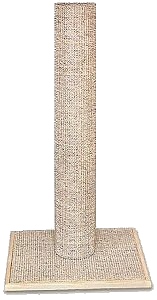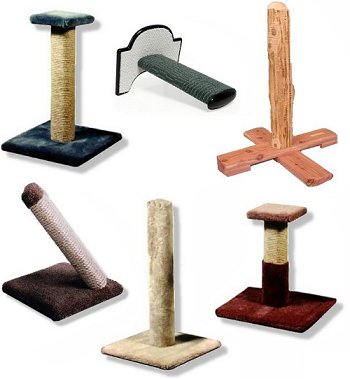| Choosing a Scratching Post This article written by Glenda Moore |
| Choosing
a scratching post for your cat is an
important consideration. Cats generally prefer to be able
to fully stretch, so a tall post (24-32") works best. Scratching
posts are made with an assortment of materials: typically,
carpet, sisal rope or sisal mesh fabric, cedar, or corrugated cardboard. Some scratching posts allow the cat to scratch horizontally, or at an angle. Scratching is one of your cat's most ingrained instincts. Keep a scratching post near where the cat usually sleeps or, if he has already picked out a corner of your sofa, keep it next to that chosen spot. You may need to train your cat to use his scratching post. Do not pick him up and put his paws on the scratching post (that will only make him want to avoid it). Make the scratching post appealing to him: rub catnip on it or mist it with catnip spray; drape a heavy string (a long leather shoelace works great) over it and wiggle it to catch his interest; put treats on the very top. Important: Invest in a scratching post that is 24" to 30" tall, with a sturdy base - your cat may be using the arm of the sofa because he can stretch higher than his scratching post will allow. Most of the ones you will find at the store are only 18" high so you may need to visit a pet supply store.  The best scratching
post, in my opinion, is made of rough sisal mesh fabric (NOT the
rope, a weave!). It's tall (29 inches), doesn't
fall over, doesn't wobble, and doesn't slide across the floor.
And, of course, the best part: all our cats love it. You
can buy rough sisal fabric from rug manufacturers (eBay is a good place
to look) and make your own scratching post, or you can buy it
ready-made. We bought ours from TopCat Sisal Products. The best scratching
post, in my opinion, is made of rough sisal mesh fabric (NOT the
rope, a weave!). It's tall (29 inches), doesn't
fall over, doesn't wobble, and doesn't slide across the floor.
And, of course, the best part: all our cats love it. You
can buy rough sisal fabric from rug manufacturers (eBay is a good place
to look) and make your own scratching post, or you can buy it
ready-made. We bought ours from TopCat Sisal Products.A few cats don't like scratching on a vertical post, but will scratch willingly on a flat scratching pad. If your cat prefers a flat surface, you can either buy one of the cardboard scratching boxes (typically available from mail order or pet stores), or buy a scrap of plywood and a carpet remnant, large enough to fold around onto the back of the plywood. Cut the corners on an angle, fold the carpet remnant over the wood, and tack the carpet on using carpet tacks or heavy-duty staples. Sometimes changing to a scratching post that is covered with sisal rope or a different texture will kindle his interest in the post, as well. Other solutions: If he's scratching wood furniture, rub strong-smelling furniture polish into it. For sofa and chair sides, cover the edges of the sofa with heavy plastic (available at your local fabric store - typically used to cover footstools or protect tablecloths - you can buy twist-pins while you're there to hold the place neatly in place) or aluminum foil (use velcro or double-stick tape to hold in place). Or spray a cloth thoroughly with one of the sprays formulated for keeping a cat off the furniture, and pin it to the sofa, chair, or your speakers (don't spray directly onto the furniture). Or, put strips of self-adhesive velcro (loop side out) on the favored scratching spots. If all else fails, everytime you see him actively clawing the furniture, spray him lightly from a bottle of water (do this only when he is actually scratching, not when he is approaching or leaving the furniture). Remember that scratching is a normal behavior - you must provide your cat with an acceptable way to do that, before you can dissuade him from scratching your furniture. Please note that declawing is the equivalent of cutting off your finger up to the first knuckle. There can be serious physical and psychological effects. |
 |